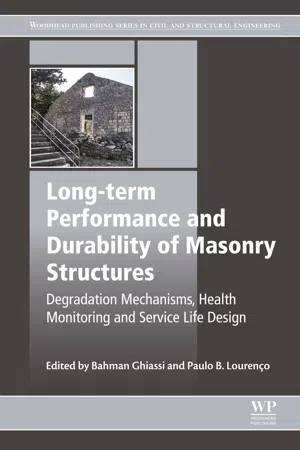
Long-term Performance and Durability of Masonry Structures
Degradation Mechanisms, Health Monitoring and Service Life Design
- 422 pages
- English
- ePUB (mobile friendly)
- Available on iOS & Android
Long-term Performance and Durability of Masonry Structures
Degradation Mechanisms, Health Monitoring and Service Life Design
About this book
Long-Term Performance and Durability of Masonry Structures: Degradation Mechanisms, Health Monitoring and Service Life Design focuses on the long-term performance of masonry and historical structures. The book covers a wide range of related topics, including degradation mechanisms in different masonry types, structural health monitoring techniques, and long-term performance and service life design approaches. Each chapter reflects recent findings and the state-of-the-art, providing practical guidelines. Key topics covered include the theoretical background, transport properties, testing and modeling, protective measures and standards and codes. The book's focus is on individual construction materials, the composite system and structural performance.- Covers all issues related to durability, including degradation mechanisms, testing and design, monitoring and service life design- Focuses on different masonry construction types- Presents a 'one-stop' reference for advanced postgraduate courses that focuses on the durability of masonry and historical constructions
Frequently asked questions
- Essential is ideal for learners and professionals who enjoy exploring a wide range of subjects. Access the Essential Library with 800,000+ trusted titles and best-sellers across business, personal growth, and the humanities. Includes unlimited reading time and Standard Read Aloud voice.
- Complete: Perfect for advanced learners and researchers needing full, unrestricted access. Unlock 1.4M+ books across hundreds of subjects, including academic and specialized titles. The Complete Plan also includes advanced features like Premium Read Aloud and Research Assistant.
Please note we cannot support devices running on iOS 13 and Android 7 or earlier. Learn more about using the app.
Information
Clay bricks
Abstract
Keywords
1.1. Introduction
1.2. Origin and properties of clay bricks
1.2.1. Raw material characteristics
Table of contents
- Cover image
- Title page
- Table of Contents
- Copyright
- List of contributors
- Preface
- Part One. Durability and degradation mechanisms of bare and strengthened masonry
- Part Two. Health monitoring and testing
- Part Three. Long-term performance and service life design
- Index